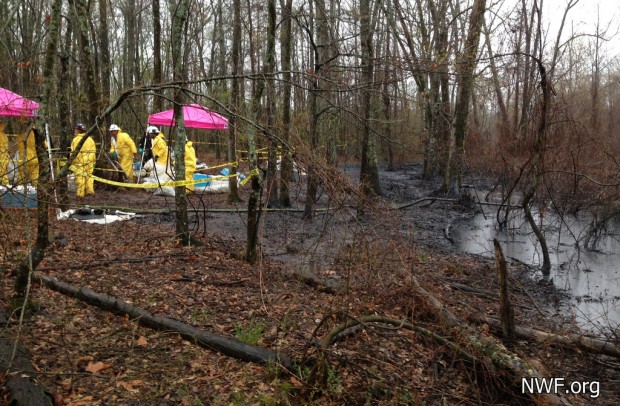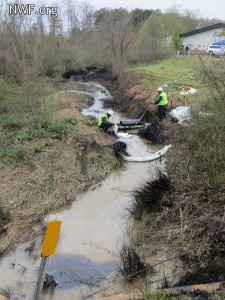We have much more to do and your continued support is needed now more than ever.
The Lies of a Tar Sands Spill — Take Two
Oil from an Exxon tar sands pipeline rupture continues to spread — coating a creek, wetland, homes and making its way toward a nearby lake. Making matters worse, the rainy weather forecasted for coming days will continue to hinder the containment effort. You might recognize the Exxon name, as they were the oil company behind the Yellowstone River pipeline spill a couple years ago, and of course nobody can forget the Exxon Valdez tanker spill in Prince William Sound, Alaska 24 years ago.

Last week, the Exxon pipeline burst near Mayflower, Ark., flooding wetlands and neighborhoods with toxic tar sands dilbit. The pipeline is more than 70 years old and Exxon was recently fined for failing to perform regular maintenance on the line. Very little is known about what’s actually happening, but recent aerial footage has given light to a much bigger problem for this community and Exxon.
[youtube]http://www.youtube.com/watch?v=3iIdWGGlBP8[/youtube]
NWF has been saying for years that the oil industry is not applying lessons learned from the Enbridge tar sands disaster and this Exxon spill proves that point unbelievably:
- Exxon had to be told that their tar sands pipeline broke as a river of tar sands oil flowed in and around homes and wetlands. Exxon is still working to stop the flow of oil from reaching nearby Lake Conway, which also happens to be the water resources for the nearby communities. Similarly, Enbridge had to be told about their million gallon spill – that tar sands spill went unreported for almost 17 hours and impacted nearly 40 miles of the Kalamazoo River! A State of Emergency was issued by the governor of Michigan to bring in resources to prevent the oil from hitting Lake Michigan.
- Exxon seems to be grossly underestimating the amount of tar sands spilled: they originally reported only 80,000 gallons spilled, but now that figure is closer to 400,000 gallons. Judging by the photos and videos, I would guess the figure will continue to rise. Enbridge also underestimated the original spill amounts, which is still under debate to this day. Enbridge also estimated the clean-up would take weeks, which has now turning into years. This is the same story Exxon is selling to the media and their failure to face the facts continues to cause major delays in the cleanup, which will only continue to impact the communities and wildlife negatively.
- Because of these low spill figures, Exxon has been allowed to get away with a pathetic response and responders are not showing signs of using spill equipment that accounts for the fact that this oil will sink in the wetlands and water impacted. It took Enbridge months to admit that the tar sands heavy crude sank in the river and wetlands, and by that time all the damage had been done. Because response to tar sands spills is much harder and much more expansive, I am guessing that Exxon will continue to try and hide the facts. Enbridge and the EPA are still trying to figure out how to clean-up tar sands oil submerged in the Kalamazoo River.
- Wildlife response is incredibly lacking and continues to be limited by Exxon — due to their potential liability. One group that has stood up in the face of this disaster is Helping Arkansas Wildlife Kritters. We want to thank them for their leadership in response. However, it appears that an Exxon contractor will soon take over all wildlife response efforts. We hope that federal agencies will also step in to ensure that response is being handled properly. It took Enbridge nearly two weeks to have their wildlife center in full gear. In those two weeks, local rescues along the Kalamazoo River tried to take matters into their own hands, but were quickly shut down because Enbridge considered their wildlife response a liability. My heart breaks for the wildlife and people that continue to be impacted.

Tar sands heavy crude, from an Exxon pipeline, overtakes an Arkansas creek - Transparency is nowhere to be found – leaving impacted residents confused and angry. Exxon has evacuated between 20-40 families and I have a feeling the evacuation zone could increase. It is critical to get people and wildlife out of the impacted area as quickly as possible because the benzene (part of the diluents used to transport tar sands through pipelines) is at unsafe concentrations in the days immediately following a release. Benzene is considered a carcinogen. Enbridge had major delays, but ended up evacuating homes within a few hundred feet of the Kalamazoo River because exposure to the chemicals was a major concern. Because of confusion and delays in those evacuations, over 300 people reported having health issues related to exposure to the tar sands crude. Ultimately, Enbridge ended up buying around 150 homes from families living along the Kalamazoo River because contamination was so widespread.
For almost 3 years now, many people (including myself) have been fighting to try and get the oil industry, our regulators and lawmakers to pay attention to the lessons learned from the Enbridge Kalamazoo River disaster – so it never happens again. The Exxon spill proves (again) that the focus for oil companies and pipeline operators is only on profits and not on the safety of our communities, wildlife and resources. Enbridge has also argued that the Kalamazoo River disaster was a rare situation. With not even three years between this spill and the Enbridge spill, I think we can safely say this is a precursor for what’s to come if we continue to allow the tar sands industry to expand.
It is inexcusable that our regulators let Exxon operate this incredibly old pipeline to transport tar sands crude. It is inexcusable that our regulators and decision makers are allowing any tar sands pipeline projects to move forward without proper spill response plans. And it is inexcusable for our lawmakers not to demand safety over oil profits.
What will it take for us to change? Last week, the National Wildlife Federation, through the filing of a rulemaking petition, lead a coalition of concerned citizens and organizations by called for a moratorium on tar sands pipelines projects and expansions until the EPA and PHMSA create tar sands pipeline regulations that account for these issues – and many more. Please help support this effort by contacting those agencies and speaking up for wildlife and those impacted by this latest disaster.





















